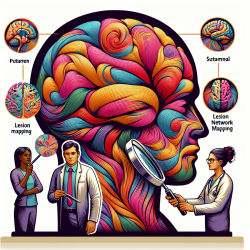Stuttering is a complex speech disorder that affects communication and can lead to social anxiety. While most cases are developmental, some individuals experience stuttering following brain injuries, such as strokes. Recent research has shed light on the neuroanatomical underpinnings of stuttering, offering valuable insights for practitioners in the field of speech therapy.
The Role of Brain Lesions in Stuttering
Stuttering can arise from focal brain damage, providing a unique opportunity to study the brain regions involved. A recent study utilized lesion network mapping to analyze cases of acquired neurogenic stuttering post-stroke. This technique identifies common networks connected to lesion sites across different individuals.
The research found that despite the diverse locations of brain lesions causing stuttering, they were all functionally connected to a network centered around the left putamen. This network also includes the claustrum and amygdalostriatal transition area. These findings suggest a shared neural basis for both acquired and developmental stuttering.
Implications for Speech Therapy
Understanding the brain's role in stuttering can significantly enhance therapeutic approaches. Here are some ways practitioners can apply these findings:
- Targeted Interventions: Focus on exercises that engage the left putamen and related areas to potentially improve speech fluency.
- Personalized Therapy Plans: Use neuroimaging data to tailor interventions based on individual brain activity patterns.
- Holistic Approaches: Consider both motor and emotional aspects of stuttering by addressing anxiety and avoidance behaviors linked to these brain regions.
- Continued Research: Encourage further studies to explore how these neural networks can be influenced through therapy or neuromodulation techniques.
The Future of Stuttering Research
This study opens new avenues for understanding and treating stuttering by highlighting the importance of specific brain networks. For practitioners, staying informed about such research is crucial for developing effective treatment strategies. By integrating these insights into practice, therapists can offer more comprehensive care to individuals who stutter.
For those interested in delving deeper into this research, you can access the original paper titled Localization of stuttering based on causal brain lesions.










